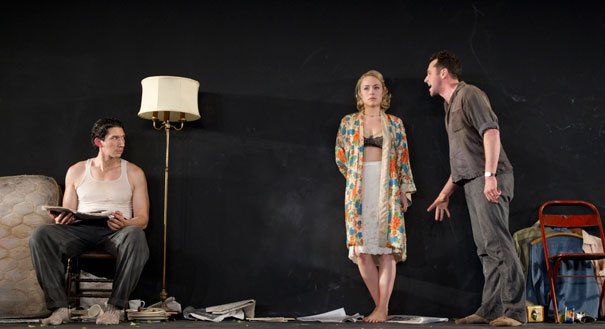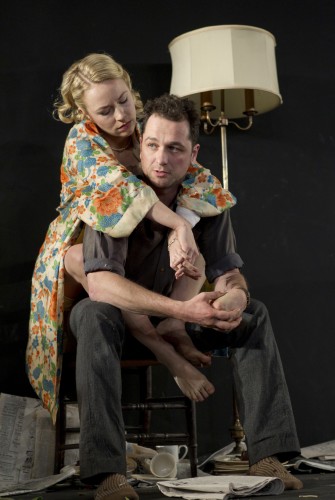
Cliff (Adam Driver), Alison (Sarah Goldberg), and Jimmy (Matthew Rhys) are rather intimate roommates in Roundabout revival (photo by Joan Marcus)
Roundabout at Laura Pels Theatre
Harold and Miriam Steinberg Center for Theatre
111 West 46th St. between Sixth & Seventh Aves.
Through April 8, $71-$81
212-719-1300
www.roundabouttheatre.org
In 1956, John Osborne’s autobiographical Look Back in Anger exploded onto the British theater scene, taking the familiar English drawing-room comedy and turning it inside out and upside down, railing about class warfare, politics, sex, family, and social structure in a less-than-polite manner. It was written by an angry young man, Osborne, about an angry young man, Jimmy Porter, who spewed venom at every opportunity. The original stage production moved to Broadway in 1957, where it was nominated for a Tony for Best Play, and the next year it hit the big screen with Richard Burton playing Jimmy; all three versions were directed by Tony Richardson, who went on to make such highly regarded films as The Entertainer (cowritten by Osborne), Tom Jones, and The Border. (A 1989 television movie directed by Judi Dench starred Kenneth Branagh and Emma Thompson.) Upon being named associate artist at the Roundabout, director Sam Gold (Seminar, August: Osage County) decided that his first production would be an updated version of the controversial drama, which makes an immediate impact via Andrew Lieberman’s powerful set, which transforms the Laura Pels Theatre into an intimate black box, with the stage a long, narrow horizontal platform only several feet deep, backed by a floor-to-ceiling black wall. Strewn about the stage are empty cans, half-eaten bites of food, and ragged clothing. When the cast enters, they’re nearly sitting on the audience’s lap; Gold leaves the lights on at first, as if everyone is inside this fleabag attic apartment. As Jimmy (Matthew Rhys) and his best friend, Cliff (Adam Driver), read the papers, argue, and wrestle, Jimmy’s wife, Alison (Sarah Goldberg), is busy at an ironing board, her shirt open to reveal her bra as if it’s no big deal. At the start, it’s hard to tell which of the men, if not both, is with Alison; while Jimmy goes on and on about British society, Cliff lays a flurry of kisses on Alison, who happily accepts them. But it soon becomes apparent that the loud, ranting Jimmy and the sweetly innocent, well-born Alison are indeed husband and wife, although perhaps not for long if Jimmy cannot control his nasty temper. And when Alison’s friend Helena (Charlotte Parry) arrives, she drives a wedge between the married couple that sets up a heated second act.
Making his New York theater debut, the Welsh Rhys is a commanding force onstage, searing with electric energy while hiding a subtle vulnerability looming just beneath his angry veneer. The play has lost some of its punch over the years; the original’s attack on British society is much tamer and too general in a world all too familiar with such public criticism. Gold’s direction overcomes many of those flaws, adding a suprising intimacy; when Jimmy and Cliff fight, it feels like they could fall off the stage at any moment. And the night we saw the show, when Jimmy slams a drawer against the back wall, one of the resulting pieces of broken wood nearly struck a man sitting in the first row. Gold has also eliminated one of the main characters, Colonel Redfern, which turns out to be a wise decision, as he’s not missed at all. But this is Rhys’s show all the way; his Jimmy is a compelling character who initially does not elicit sympathy for all his mean-spirited mad ramblings, but by the end it is clear why Alison, Cliff, and Helena are so drawn to him, as you will be too. Look Back in Anger might not be quite as angry as it once was, but it is still well worth a look back in this strong, fiery production.
